Texas Instruments AM64x is a family of 64-bit Arm processors with functional safety designed for Programmable Logic Controllers (PLC), motor drives, remote I/O, and industrial robots. The top-end processor of the family, AM6442, comes with seven cores including two Cortex-A53 application cores, four Cortex-R5F real-time cores, and one Cortex-M4F isolated core.
AFAICT, while the documentation is dated January 2021 and TI announced the processor in February in a blog post with a cryptic title, it was only first picked up by Embedded Computing in early May. Besides the processor itself, TI also provides an AM64x starter kit and a full-featured AM64x evaluation kit, and several companies are already preparing development boards and modules as we’ll see further below.
TI AM64x processor
AM64x key features & specifications:
- CPU cores
- Dual-core Arm Cortex-A53 processor @ 1.0 GHz with 256KB L2
shared cache with SECDED ECC, 32KB L1 D-cache, 32KB L1 I-cache - Up to two Dual-core Arm Cortex-R5F real-time MCU subsystems at up to 800 MHz with 32KB I-cache, 32KB D-cache and 64KB TCM per each R5F core for a total of 256KB TCM (max)
- Single-core Arm Cortex-M4F MCU at up to 400 MHz with 256KB SRAM with SECDED ECC
- Dual-core Arm Cortex-A53 processor @ 1.0 GHz with 256KB L2
- Memory subsystem
- Up to 2MB of On-chip RAM (OCSRAM) with SECDED ECC
- LPDDR4, DDR4 memory controller with inline ECC up to 1600 MT/s
- General-Purpose Memory Controller (GPMC)
- Storage
- 2x Multi-Media Card/Secure Digital (MMC/SD/SDIO) interfaces: 4-bit for SD/SDIO, 8-bit for eMMC
- Flash subsystem configurable as Octal SPI (OSPI) or Quad SPI (QSPI)
- Industrial subsystem
- 2x gigabit Industrial Communication Subsystems (PRU_ICSSG) with support for Profinet IRT, Profinet RT, EtherNet/IP, EtherCAT, Time-Sensitive Networking (TSN), and more
- Each PRU_ICSSG contains – 2× 10/100/1000 Ethernet ports, 6 PRU RISC cores, 3x Data RAMs with ECC, 8x banks of 30 × 32-bit register scratchpad memory, interrupt controller and task manager, 2x 64-bit Industrial Ethernet Peripherals, 18× Sigma-Delta filters, 6× Multi-protocol position encoder interfaces, 16550-compatible UART for Profibus
- System on Chip (SoC) Services:
- Device Management Security Controller (DMSC-L) to manages system services including initial boot, security, and clock/reset/power management
- Data Movement Subsystem (DMSS) – Block Copy DMA (BCDMA), Packet DMA (PKTDMA), Secure Proxy (SEC_PROXY), Ring Accelerator (RINGACC)
- High-speed interfaces:
- 1x Integrated Ethernet switch supporting up to 2x RGMII (10/100/1000M), IEEE 1588 with 802.1AS PTP, Energy-efficient Ethernet (802.3az)
- 1x PCI-Express Gen2 controller
- 1x USB 3.1-Gen1 Dual-Role Device (DRD)
- General connectivity
- 6× I2C,7x SPI (MCSPI),
- 9x UART modules, 6x Fast Serial Interface Receiver (FSI_RX) cores, 2× Fast Serial Interface Transmitter (FSI_TX) cores
- 12-Bit Analog-to-Digital Converters (ADC) up to 4 MSPS, 8x multiplexed analog inputs
- 6x Fast Serial Interface Receiver (FSI_RX) cores
- 3x GPIO modules
- Control interfaces
- 9x Enhanced Pulse-Width Modulator (EPWM) modules
- 3x Enhanced Capture (ECAP) modules
- 3x Enhanced Quadrature Encoder Pulse (EQEP)
modules - 2x Modular Controller Area Network (MCAN) modules with or without full CAN-FD support
- Security
- Secure boot with hardware-enforced Root-of-Trust (RoT), IP protection;
- Cryptographic acceleration – AES up to 256-bit, 3DES up to 168-bit, MD5, SHA1, SHA2 up to 512-bit, DRBG with true random number generator, PKA (Public Key Accelerator) to assist in RSA/ECC processing
- Debugging security
- Trusted Execution Environment (TEE), Arm Trustzone-based
- Secure storage support
- On-the-Fly encryption and authentication
- Networking security support for data (Payload) via packet-based
hardware cryptographic engine - Security co-processor (DMSC-L) for key and security management, with dedicated device-level interconnect for security
- Power management:
- Simplified power sequence
- Integrated SDIO LDO for handling automatic voltage transition for SD interface
- Integrated voltage supervisor for safety monitoring of over-under voltage conditions
- Integrated power supply glitch detector for detecting fast supply transients
- Functional Safety compliance
- Documentation will be available to aid IEC 61508 functional safety system design
- Systematic capability up to SIL 3
- Hardware integrity up to SIL 2 targeted for MCU domain
- IEC 61508 certification (pending)
- Dedicated MCU domain memory, interfaces, and M4F core capable of being isolated from the larger SoC with Freedom From Interference (FFI) features
- Package – 17.2x 17.2 mm, 0.8-mm pitch, 441-pin BGA
- Manufacturing process – 16nm FinFET technology
There’s a pretty large number of boot options of the processor with UART, I2C, OSPI/QSPI Flash, SPI Flash, parallel NOR Flash, parallel NAND Flash, SD, eMMC, USB 2.0, PCIe, and Ethernet interfaces.
There are six AM64x parts now with AM6442, AM6441, AM6422, AM6421, AM6412, AM6411 which all seem to be pin-to-pin compatible, and only differ in terms of Cortex-A53 or Cortex-R5F cores, amount of TCM memory, and support for CAN-FD and/or industrial communication subsystem.
You’ll find more technical details in the 252-page datasheet, as well as links to the individual parts.
AM64x starter kit and evaluation board
As noted in the introduction, Texas Instruments offers two development platforms with a starter kit, and an evaluation board with more features and interfaces. Let’s have a quick look at both.
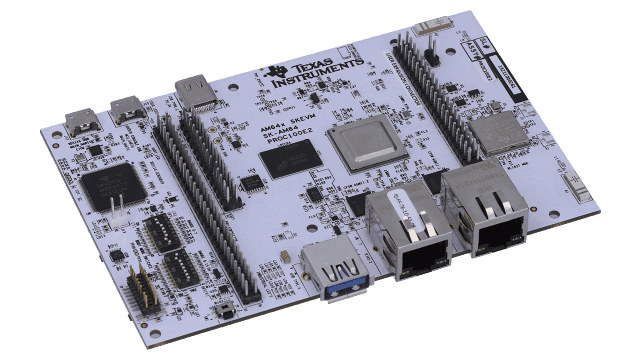
The board companies with a 7-core AM64x processor (which should be AM6442), 2GB LPDDR2, 16 MB OSPI, a microSD card slot, a dual-band Wi-Fi * Bluetooth 5.1 module (WiLink 8 WL1837MOD), two RJ-45 Gigabit Ethernet port, a USB 3.1 port, a micro USB port for serial (3x UART), a JTAG emulator, a 40-pin Raspberry Pi expansion header, plus PRU, real-time I/O and TI-MCU headers.
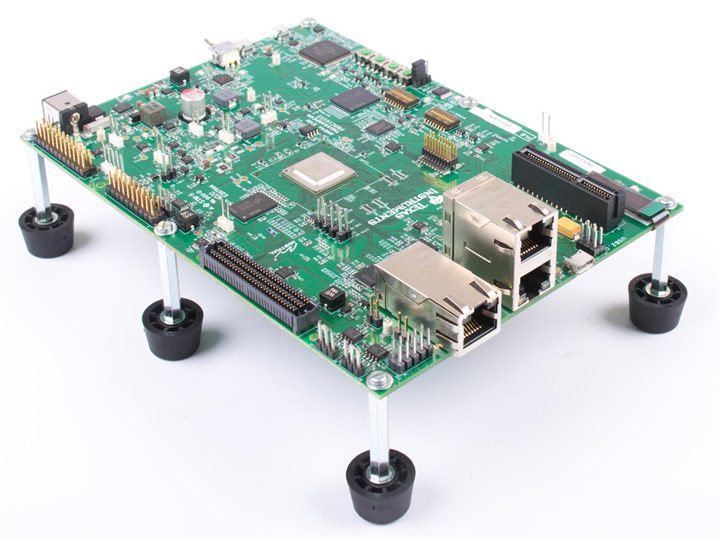
The evaluation kit has many of the same features but comes with a 16GB eMMC flash, three RJ45 100/1000M Ethernet ports, a 1-inch display, a 4-lane PCIe connector, an FSI interface to connect C2000 MCU, on-board measurement capabilities, and more. There’s no wireless module.
Both kits are supported by the TI Processor SDK with Linux/ RT Linux kernel, Yocto filesystem, and out-of-box demos.
AM64x starter kit is sold for $99, while the AM64x GP EVM development platform goes for $299. You’ll find more information on the product page for the starter kit and EVM.
Upcoming third-party AM64x systems-on-module
There are at least three companies that have already announced, or at least set up a product page for their AM64x system-on-module, with SolidRun SoM that also includes a sub-GHz SimpleLink microcontroller for 6LoWPAN/MIOTY, PHYTEC phyCORE-AM64x module, and TQ Embedded’s TQMa64xxL with four real-time Ethernet interfaces.
The modules should really become broadly available in 2022 with TQ Embedded announcing availability in Q1 2022, and PHYTEC expecting ALPHA samples of the module in Q4 2021.
Via LinuxGizmos

Jean-Luc started CNX Software in 2010 as a part-time endeavor, before quitting his job as a software engineering manager, and starting to write daily news, and reviews full time later in 2011.
Support CNX Software! Donate via cryptocurrencies, become a Patron on Patreon, or purchase goods on Amazon or Aliexpress. We also use affiliate links in articles to earn commissions if you make a purchase after clicking on those links.


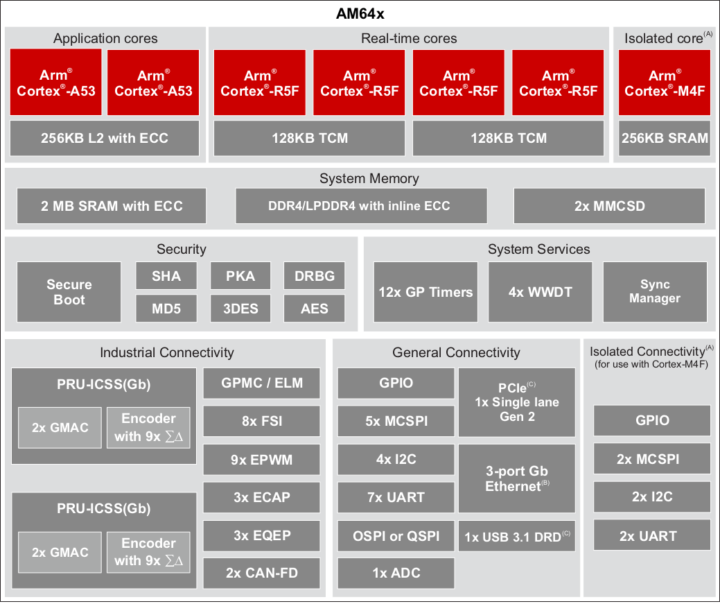
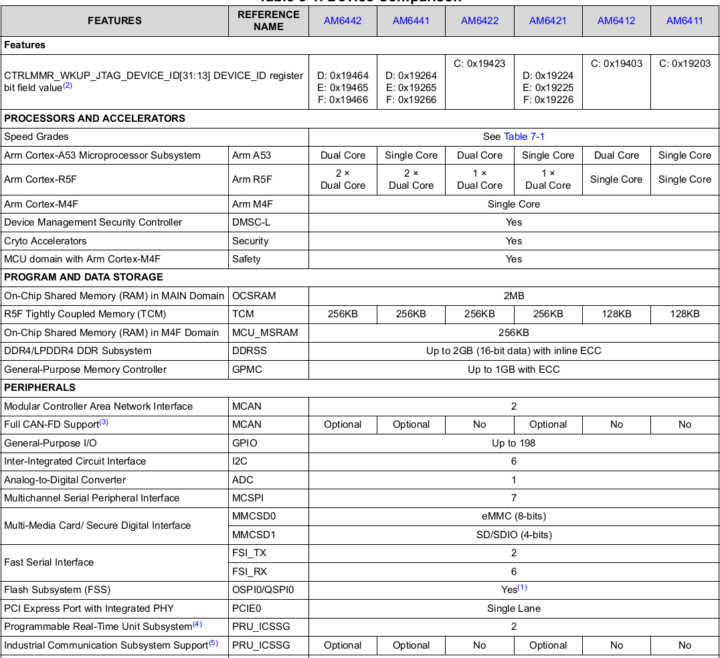
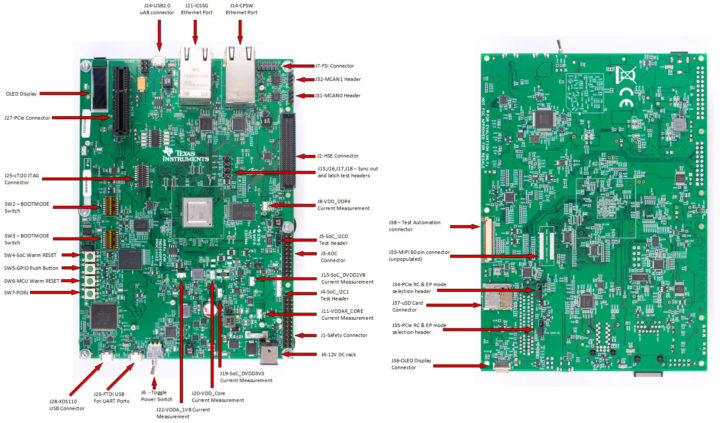


Someone went overboard. With all these cores it would be a nightmare to program this thing and avoid race conditions.
I don’t think this is for you.
There are really only two application cores, the R5 cores are for an RTOS, so that’s more like a special purpose part of the chip. The M4 core appears to be for some kind of security applications. All of the minor “cores” are also MCUs, not full on CPUs.
A candidate for a new beagle?
There will allegedly be a new BeagleBone board based on AM752x
https://www.cnx-software.com/2020/06/28/j721e-dra829-tda4vm-am752x-texas-instruments-cortex-a72-based-monster-soc/#comment-583301
This looks like a nice chip, if you have use for its cores and peripherals and don’t need graphics. NXP’s closest competitor appears to be i.MX8M Plus, though with a different focus. Both are rather expensive chips, alas.